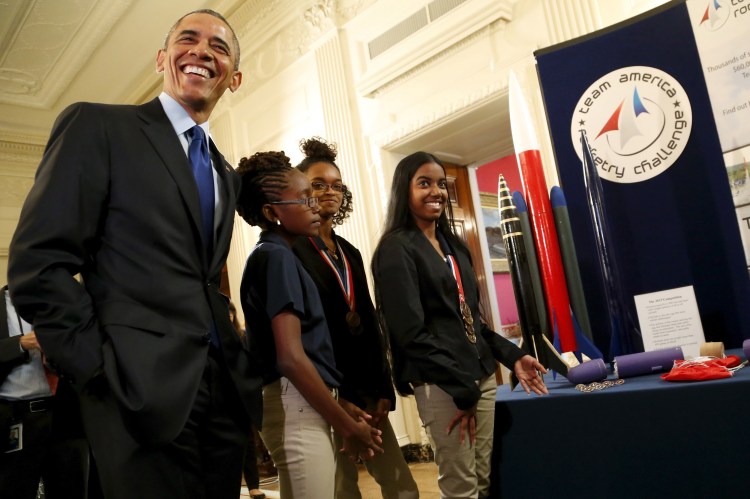President Barack Obama wants to make computer science more accessible in schools around the United States. Today he unveiled his Computer Science for All initiative, a program that’ll make investments in not only the state and local levels, but also with federal agencies. The goal is to train teachers so that they in turn can encourage their students to learn computer science.
At this year’s State of the Union address, President Obama said, “In the coming years, we should build on [the increase of high school graduation rates and boosted graduates in fields like engineering] by … offering every student the hands-on computer science and math classes that make them job-ready on day one.” His administration believes that now is the time to achieve this goal as a “new basic” skill necessary to achieve better paying jobs and moving up in society.
Making investments in teachers
President Obama’s initiative is the latest effort to improve science, technology, engineering, and math (STEM) opportunities for the nation’s students. To accomplish this goal, the White House will provide $4 billion in funding to states and $10 million to districts as part of the upcoming budget proposal. The money would go toward training teachers, expanding access to resources and training material, and establishing partnerships.
Starting this year, the National Science Foundation said it will provide $120 million towards the Computer Science for All initiative over the next five years. The funds will be used to create research foundations aimed at developing and implementing sound academic computer science instructions in the schools. This includes “prototyping of instructional materials, scalable and sustainable professional development models, approaches to pre-service preparation for computer science teachers, and teacher resources at the K-12 grade levels.” It’s estimated that the investment will prepare up to 9,000 additional high school teachers in computer science by 2021.
The Corporation for National and Community Service (CNCS) is also committing to the cause, putting $17 million in Segal AmeriCorps Education Awards toward teacher training. The CNCS is a federal agency develops community solutions through its AmeriCorps, Senior Corps, and Social Innovation Fund programs. Over the next three years, it’ll work alongside the NSF and the STEM organization 100Kin10 to help thousands of teachers access the AmeriCorps Educational Awards and to help pay for teachers to be trained in computer science.
In addition, 100Kin10 has pledged to help its 200-plus partners prepare more than 10,000 teachers to teach computer science by 2021. The organization, consisting of companies like the New York Academy of Sciences, SRI International, the University of New Hampshire, and Teach For America, will launch a $1 million “coopetition” to find the best ways to prepare and support engineering in K-12 schools in New York state, with a focus on computer science.
Other federal agencies such as the Department of Defense, the National Math and Science Initiative, and the Department of Education’s Office of Career, Technical, and Adult Education and its 21st Century Community Learning Centers program are also involved in promoting computer science in schools.
The last piece of the program is to motivate leaders at all levels to participate in this process. President Obama wants to get governors, mayors, education leaders, CEOs, philanthropists, and others involved. Right now, the states of Delaware and Hawaii, along with more than 30 school districts in the United States, have committed to expanding computer science opportunities.
Private sector firms have also pledged contributions, such as Cartoon Network’s $30 million effort to get young people to learn creative coding; Apple’s expansion of coding opportunities for children and additional investments in training workshops; Facebook’s outreach to parents and students in communities underrepresented in the tech sector; Google’s additional investment of $23 million to support K-12 computer science education in order to reach 5 million more students; Microsoft’s campaign to encourage all 50 states to adopt Make CS Count policies and invest in computer science education; and Code.org’s goal to prepare 25,000 more teachers to teach computer science this year.
The growing need for STEM education
The White House said that last year there were over 600,000 available jobs in tech and by 2018, 51 percent of all STEM jobs are estimated to be in a computer science-related field. And the demand keeps growing — the federal government alone needs an additional 10,000 professionals to help manage its IT infrastructure and cybersecurity. “Providing access to [computer science] is a critical step for ensuring that our nation remains competitive in the global economy and strengthens its cybersecurity,” the Obama administration wrote.
The launch of the Computer Science for All initiative isn’t the first time President Obama has promoted this field. In his two terms, he has created the White House Science Fair; started the Educate to Innovate initiative; signed into law the Every Student Succeeds Act (ESSA), which increases the opportunities states and school districts have to offer computer science coursework; became the first sitting president to learn how to code; and hosted the inaugural White House Demo Day.
President Obama’s latest initiative doesn’t appear to be just talk. He has worked alongside multiple partners — on the federal, state, and local levels as well as in the private sector — to generate commitments to improving computer science opportunities for millions of students. It starts with making sure that the teachers are educated first before branching out to encourage everyone to be strong in STEM.
VentureBeat's mission is to be a digital town square for technical decision-makers to gain knowledge about transformative enterprise technology and transact. Learn More

